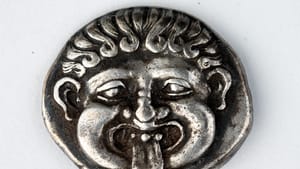Stay in the Loop
BSR publishes on a weekly schedule, with an email newsletter every Wednesday and Thursday morning. There’s no paywall, and subscribing is always free.
Do you believe in magic?
Magic in the Ancient World at the Penn Museum

No one believes in magic anymore.
Oh sure, we avoid black cats, sidewalk cracks, and notice when the 13th falls on a Friday. We wear special socks to the big game. We perform little rituals before an important test. Silly things, really, yet we take pains not to violate them. Not that it constitutes magical belief, because we don’t believe in magic.
Except when we do.
Magical thinking
Ancient cultures also sought supernatural help for this life and the next through objects, words, and practices. They formed belief systems to obtain a sense of control over the uncontrollable, enabling them to cope with the unknown. Whether Egyptian, Greek, Mesopotamian, or Roman, ancient peoples wanted what we want: protection, vengeance, health, wealth, and eternal happiness. The objects and practices in which they invested confidence are examined in Magic in the Ancient World at Penn Museum. As the exhibit makes clear, despite the intellectual advancement of the last two millennia, we still have a lot in common with our ancestors when it comes to managing hopes and fears.
To protect and terrify
Across centuries and cultures, similarities developed in belief systems. While horseshoes and four-leaf clovers were not prized by the ancients, animal charms were thought to carry good luck, particularly amulets of birds, bulls, snakes, and a frog — of which a 3,000-year-old Iraqi silica glass example is on view. Sometimes, animal and human features were combined to ward off danger. An Egyptian faience amulet (945-712 BCE) features the gnome-like god Bes, believed to protect women, children, and the home. The grimacing figure appears with a lion’s mane, feathered headdress, and sticks out his tongue at all threats.
The Greeks relied on Gorgons. The snake-haired females (Medusa was a Gorgon) could turn foes to stone with a mere glance. A tiny silver coin (411-350 BCE) from Macedonia would have offered its owner protection as well as promotion, bearing a Gorgon on one side and Nike, the Greek goddess of victory, on the other.
Words and objects
There is a beautiful grouping of incantation bowls, some as many as 1,700 years old. Mesopotamians placed the bowls, inscribed with words spiraling from lip to well, upside down at the entrance to their homes, to trip up demons and protect inhabitants from harm. Not so different from Jewish families affixing a mezuzah, a small container holding a scriptural passage, at the threshold of their homes.
Religious parallels
The parallels between magical and religious beliefs are undeniable, if only on a superficial level. A stone stela (664-30 BCE) from Egypt depicts Horus, hidden as an infant by Isis in marshes (Moses in the bulrushes, anyone?). Horus was cured of illness by enduring scorpion stings and snakebites. This lore led Egyptians to believe that water poured over the stela acquired curative power, restoring the health of those who drank it or anointed themselves. Water is central to religious rites too, integral to Christian baptism, Jewish ritual baths, and even the simple act of dipping a hand into a font of blessed water upon entering or leaving a Catholic church.
A human response
While the faithful don’t consider their beliefs to be magic, it isn’t disrespectful to acknowledge that many of the practices on view at Penn are inspired by the same longings as religious devotions. And as the exhibition depicts, one early Christian movement, Gnosticism, incorporated magic elements in its canon, such as secret knowledge and objects that conveyed godlike power.
Magic in the Ancient World, curated from Penn Museum holdings, is a concise and evocative survey of the ways in which the peoples of the Mediterranean, both before and during the Common Era, responded to a world not unlike our own, imperfect, dangerous, often beyond our control. Whatever form the response takes — whether magic, superstition, or faith — its genesis is undeniably human.
What, When, Where
Magic in the Ancient World. Through April 30, 2017 at Penn Museum, 3260 South Street, Philadelphia. (215) 898-8183 or penn.museum.
Sign up for our newsletter
All of the week's new articles, all in one place. Sign up for the free weekly BSR newsletters, and don't miss a conversation.